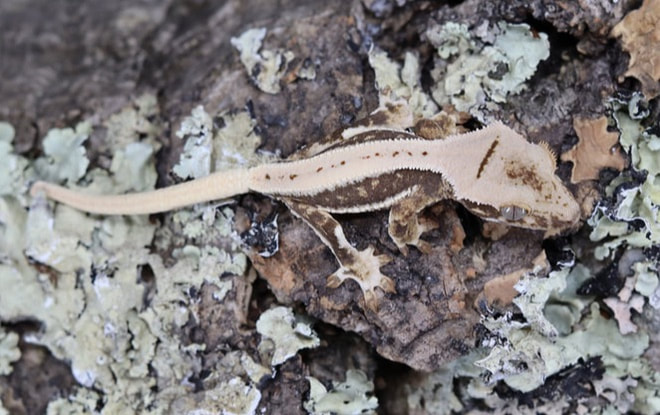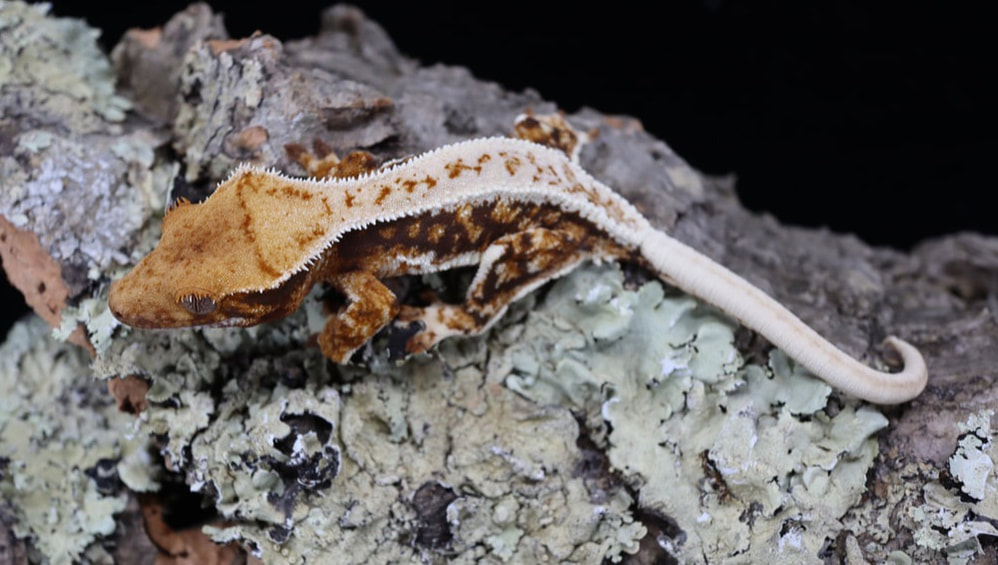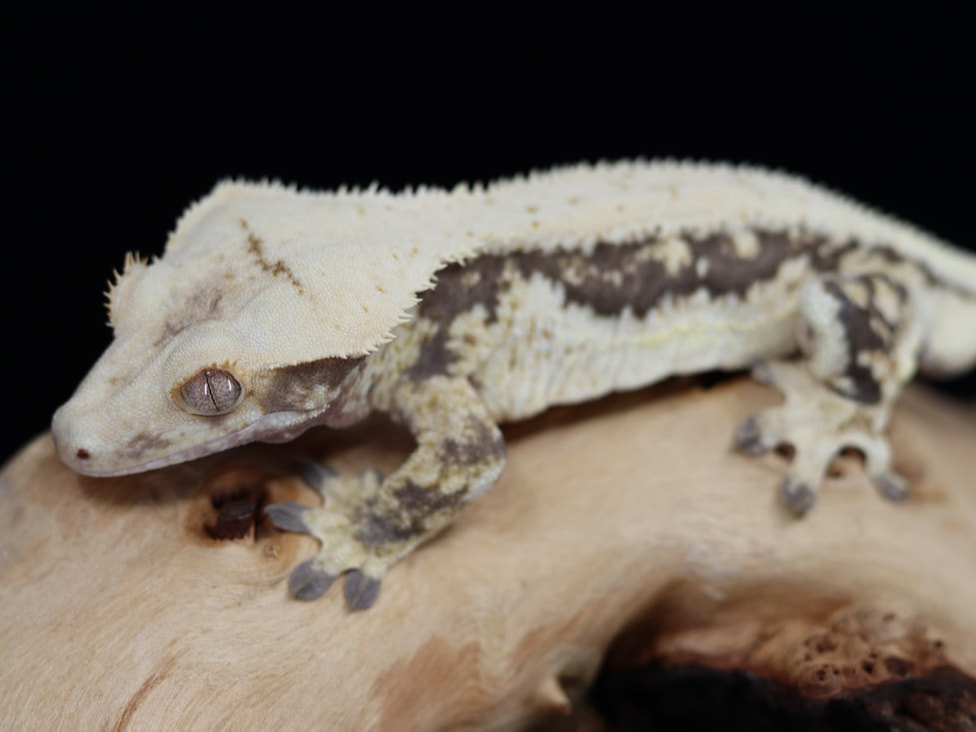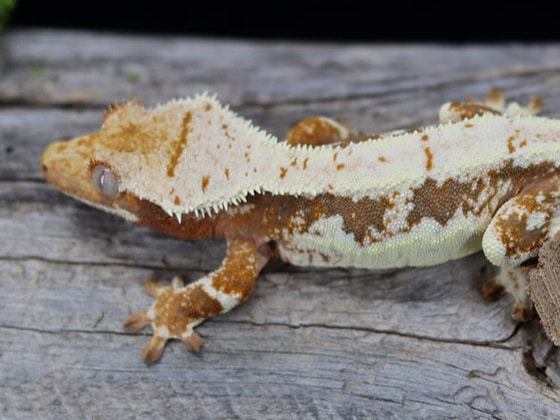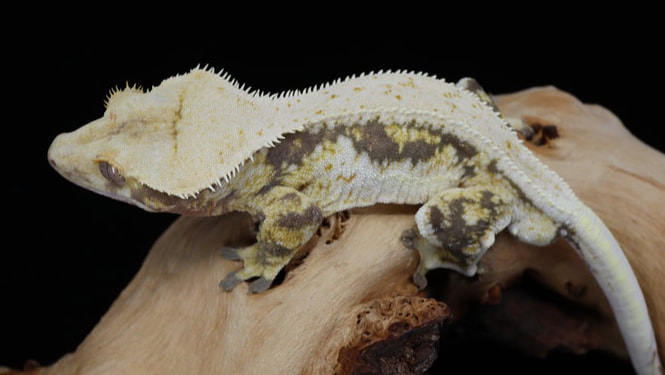Lilly White Crested Gecko Project
|
Whether it is the bright whites or the creamy coverage of the gene that attracts you, there is something special about Lilly White crested geckos. We were completely amazed with this morph from the first time we saw one. Then when looking around and discovering the different base colors, creams, and white we were hooked.
Crested Geckos have always had a wide variety of colors and patterns, which have been hard to pinpoint on what traits will carry over to the offspring. These colors and pattern variations have proven to be traits and not so genetic specific. The Lilly White gene has proven to be genetic and carries over to the offspring. |
Lilly White Crested Gecko History
The name “Lilly White” was coined by the breeder Nick Lumb of Lilly Exotics, who established the trait. Lilly Exotics is in the United Kingdom and discovered the trait when a unique gecko hatched out in late 2010. This white creamy gecko was different than all the other geckos and they kept it for their own breeding project.
They bred this unique looking gecko a couple of years later to multiple females and soon would discover the trait did pass on to some of the offspring (co-dominant trait). The next question, which is common in the reptile world, would be what do you get from breeding two Lilly Whites together? The answer would come from the pairing, but was bittersweet.
When breeding two visual Lilly Whites together they produce a “super” form (dominant trait) which is an all-white gecko. This color morph found in reptiles and animals is often called leucistic. Unfortunately, the trait seems to be fatal and the geckos do not live. Some have made it to hatching and have taking a few steps, but none have survived.
Discovering a super form solidified that the Lilly White trait is a visual heterozygous (het.). This trait affects the color, feel, and patterns and has now been bred to many established colors and traits in crested geckos resulting in gorgeous, unique looking geckos.
They bred this unique looking gecko a couple of years later to multiple females and soon would discover the trait did pass on to some of the offspring (co-dominant trait). The next question, which is common in the reptile world, would be what do you get from breeding two Lilly Whites together? The answer would come from the pairing, but was bittersweet.
When breeding two visual Lilly Whites together they produce a “super” form (dominant trait) which is an all-white gecko. This color morph found in reptiles and animals is often called leucistic. Unfortunately, the trait seems to be fatal and the geckos do not live. Some have made it to hatching and have taking a few steps, but none have survived.
Discovering a super form solidified that the Lilly White trait is a visual heterozygous (het.). This trait affects the color, feel, and patterns and has now been bred to many established colors and traits in crested geckos resulting in gorgeous, unique looking geckos.
What does a Lilly White look like?
Most will notice the bright whites and cream colors that are taking over the gecko first or the silvery ice eyes, but I honestly feel that it is difficult to explain what one is besides saying a really nice white or creamy gecko. It gets even more confusing since the discovery of a Phantom Lilly trait which lacks most of the white coverage except on the bottom flanks of the animal.
Since most people searching the internet about Lilly Whites will see photos of babies I will start with babies. The first thing that we look for with hatchlings is a sold white tail. This is consistent with the trait including the phantom trait. The tail will be white or cream from the base to the tip with no breakage of the color when looking at the tail from a top view. The tail can have coverage of pattern and color on the bottom but it will not cross over to the top of the tail. The lower end of the tail near the end may have a slightly different color or even what looks like grey stippling but it will not create a pattern that you see in non-Lilly White geckos.
The next thing that we look for is slightly larger and raised scales that are on the flanks of the gecko. These can be a row or scales or a few scales in the area. These scales will also be white or cream. The flank area’s white coloring is often more bright and whiter than what the dorsal will look like on a hatchling and young gecko.
Since most people searching the internet about Lilly Whites will see photos of babies I will start with babies. The first thing that we look for with hatchlings is a sold white tail. This is consistent with the trait including the phantom trait. The tail will be white or cream from the base to the tip with no breakage of the color when looking at the tail from a top view. The tail can have coverage of pattern and color on the bottom but it will not cross over to the top of the tail. The lower end of the tail near the end may have a slightly different color or even what looks like grey stippling but it will not create a pattern that you see in non-Lilly White geckos.
The next thing that we look for is slightly larger and raised scales that are on the flanks of the gecko. These can be a row or scales or a few scales in the area. These scales will also be white or cream. The flank area’s white coloring is often more bright and whiter than what the dorsal will look like on a hatchling and young gecko.
Gecko bellies are always cute to see and vary greatly in normal type geckos. Lilly White geckos will have their whites and creams all over their bellies. You will be able to see the whites starting under your gecko and watch them spread as the gecko ages.
One trait that has always stood out to me is the eyes. Lilly White geckos tend to have icy silver colored eyes. This can be seen in young geckos but sometimes you will not notice until the gecko is a week or more older.
The skin of Lilly Whites tend to be softer than other geckos, in our opinion. This is a hard thing to explain but if you hold an adult crested gecko that is not a Lilly White then hold a Lilly White you will notice that the Lilly White gecko’s skin is a softer, more velvet like feeling to the touch. Crested Geckos in general do not have a stereotypical reptile feel and are softer than many pet lizards, but the Lilly White geckos have a noticeable difference in the feel of their scales.
The last part which is what they are known for is the whites and cream. Some are born with bright paper white coloring while many are born with a yellowish or orange color that fades with age. Most adults will be white or have a whiter cream that takes over the pattern. The dorsal will contain most of the white which might drip down from the crests that run the dorsal of the animal. The flanks will also increase the whites up towards the dorsal as the gecko ages. The hatchling gecko will change greatly with white and cream coverage as it ages. Many adult Lilly White geckos will have a yellow hue to the coloration that might appear more with age.
One trait that has always stood out to me is the eyes. Lilly White geckos tend to have icy silver colored eyes. This can be seen in young geckos but sometimes you will not notice until the gecko is a week or more older.
The skin of Lilly Whites tend to be softer than other geckos, in our opinion. This is a hard thing to explain but if you hold an adult crested gecko that is not a Lilly White then hold a Lilly White you will notice that the Lilly White gecko’s skin is a softer, more velvet like feeling to the touch. Crested Geckos in general do not have a stereotypical reptile feel and are softer than many pet lizards, but the Lilly White geckos have a noticeable difference in the feel of their scales.
The last part which is what they are known for is the whites and cream. Some are born with bright paper white coloring while many are born with a yellowish or orange color that fades with age. Most adults will be white or have a whiter cream that takes over the pattern. The dorsal will contain most of the white which might drip down from the crests that run the dorsal of the animal. The flanks will also increase the whites up towards the dorsal as the gecko ages. The hatchling gecko will change greatly with white and cream coverage as it ages. Many adult Lilly White geckos will have a yellow hue to the coloration that might appear more with age.
Lilly White crested geckos are geckos that have a high white or cream color that covers the majority of the gecko’s body. The coverage spreads greatly from when the animal hatches. A unique thing about this trait is you can produce all the different whites and creams when breading a Lilly White to a normal gecko.
Lilly Whites and the Base Color
Lilly White geckos will vary with their base colors depending on the gecko they are bred to. An interesting trait is when bred to a Super Dalmatian (heavily spotted) the offspring showing the Lilly White trait looks orange with creams and does not show all the spotting you would suspect it to have. Lilly Whites can show dalmatian traits but are not heavily spotted.
Many base colors are seen with the trait including red, yellow, brown, black, and orange. No one has publicly showcased pairings to show what type of Lilly is produced. Some examples can be found here on Lilly Exotic’s website.
Many base colors are seen with the trait including red, yellow, brown, black, and orange. No one has publicly showcased pairings to show what type of Lilly is produced. Some examples can be found here on Lilly Exotic’s website.
Our Lilly White Project
We were very fortunate to obtain two Lilly White geckos from Northern Gecko in Canada. Our Lilly Whites were produced from different fathers, both originally from Lilly Exotics. Rooney is our original female that is a red and orange-based Lilly White that has high whites. She has great coverage on her sides and has a more unique dorsal of white coverage that is not typical on the majority of Lilly Whites. Crux is our male which has a nice dark base with yellow and tan highlights. His dorsal has a unique speckling of yellow and his sides have great coverage of the white trait. These are the two Lilly Whites that started our project.
We are curious about all the color combinations that are possible with the Lilly White gene. With this in mind, our goal is to create some of the most colorful great structured Lilly White crested geckos possible and document the progress along the way.
We are curious about all the color combinations that are possible with the Lilly White gene. With this in mind, our goal is to create some of the most colorful great structured Lilly White crested geckos possible and document the progress along the way.
Reds
I have always been a fan of red and orange crested geckos. We are hoping to produce some nice red based Lilly Whites from Rooney and Bloom. We are hoping Bloom's solid structure and large head is passed down to her offspring. Bloom also has great side coverage with high creams and whites. It will be great to see what this trait does with the Lilly gene.
I have always been a fan of red and orange crested geckos. We are hoping to produce some nice red based Lilly Whites from Rooney and Bloom. We are hoping Bloom's solid structure and large head is passed down to her offspring. Bloom also has great side coverage with high creams and whites. It will be great to see what this trait does with the Lilly gene.
Black/Grey/Lavender
Amethyst is possibly our favorite gecko. She has always been calm and is just amazing to see in person. She has great whites that cover her dorsal and side. Her structure is thick and she has an amazing head with floppy crests. Her base color is a grey that sometimes shows lavender hues but she fires up a dark grey almost black. We are hoping that her amazing structure, whites, and colors translate to her Lilly White offspring.
Olive Black
Ember is a dark olive-based gecko that fires up midnight black. She is a pinstripe with an almost solid dorsal from her head to the tail. Her crests are long and follow the length of her body, with a wide head. Her unique color is what we are hoping to bring to the Lilly gene. We have not seen olive-based Lilly Whites and are hoping to produce some from her.
Amethyst is possibly our favorite gecko. She has always been calm and is just amazing to see in person. She has great whites that cover her dorsal and side. Her structure is thick and she has an amazing head with floppy crests. Her base color is a grey that sometimes shows lavender hues but she fires up a dark grey almost black. We are hoping that her amazing structure, whites, and colors translate to her Lilly White offspring.
Olive Black
Ember is a dark olive-based gecko that fires up midnight black. She is a pinstripe with an almost solid dorsal from her head to the tail. Her crests are long and follow the length of her body, with a wide head. Her unique color is what we are hoping to bring to the Lilly gene. We have not seen olive-based Lilly Whites and are hoping to produce some from her.
Yellows
We are working with a couple of screaming yellows and cream-based females now and are trying to figure out which ones we should use for this project. We are thinking of pairing Soleil with Crux to see if her bright yellow will translate to a bright Lilly or if her solid color will translate to a phantom type Lilly White.
Soft Scales
We are hoping to mix some of our soft scales like La Tigra or Zeppelin into the project to see what that trait does to an already softer gecko. We are wondering the colors will be slightly more vibrant and create a Lilly that does not fire up, but stays a more consistent color like the soft scales tend to do.
Super Dalmatian
Our Super Dalmatian girl, DeVille, is used in the axanthic project currently. We are hoping that she produces some Super Dalmatian hets with gorgeous structure. Some of her offspring we will use in the Lilly White project to see firsthand if the super dalmatian trait does in fact create the orange and cream Lilly Whites that Nick Lumb wrote about!
Axanthic
How could we not try to go for this, which seems like an ultimate goal for many breeders. We will be introducing Rooney to Henry to hopefully get some Lilly Whites that will be carrying the axanthic gene to eventually create an axanthic Lilly White. The axanthic trait seems to wash out the pattern of geckos so we are hoping the Lilly gene will pull through and create some black and grey Lilly Whites.
We are working with a couple of screaming yellows and cream-based females now and are trying to figure out which ones we should use for this project. We are thinking of pairing Soleil with Crux to see if her bright yellow will translate to a bright Lilly or if her solid color will translate to a phantom type Lilly White.
Soft Scales
We are hoping to mix some of our soft scales like La Tigra or Zeppelin into the project to see what that trait does to an already softer gecko. We are wondering the colors will be slightly more vibrant and create a Lilly that does not fire up, but stays a more consistent color like the soft scales tend to do.
Super Dalmatian
Our Super Dalmatian girl, DeVille, is used in the axanthic project currently. We are hoping that she produces some Super Dalmatian hets with gorgeous structure. Some of her offspring we will use in the Lilly White project to see firsthand if the super dalmatian trait does in fact create the orange and cream Lilly Whites that Nick Lumb wrote about!
Axanthic
How could we not try to go for this, which seems like an ultimate goal for many breeders. We will be introducing Rooney to Henry to hopefully get some Lilly Whites that will be carrying the axanthic gene to eventually create an axanthic Lilly White. The axanthic trait seems to wash out the pattern of geckos so we are hoping the Lilly gene will pull through and create some black and grey Lilly Whites.
|
© Copyright 2019- Present All Rights Reserved
|
